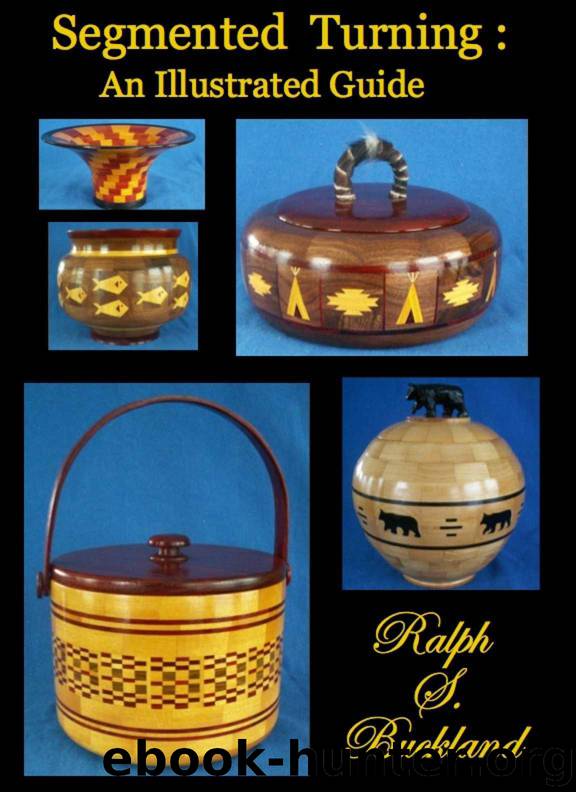Segmented Turning: An Illustrated Guide by Buckland Ralph S

Author:Buckland, Ralph S. [Buckland, Ralph S.]
Language: eng
Format: epub
Publisher: Ralph S. Buckland
Published: 2013-11-25T22:00:00+00:00
BB. Vibration Control
In this topic, I am referring to the vibrations of the project and not the lathe. The further you get away from the headstock with you project and not being supported by the tailstock or anything else the more likelihood the project will vibrate. To eliminate vibrations when cutting inside, I use a steady rest. With the hole on the top of the bowl already having been turned, turn a male joining member out of a scrap piece of wood that will fit snug into the hole. Tighten your tailstock ball bearing center against this scrap disc and this should eliminate any vibrations as you turn the outside of the bowl. When turning a lamp, I add a board in the center of the lamp permanently and use the tailstock to control the vibrations as the lamp grows taller.
CC. Finishes
Here is my wife, Kathy, finishing several of the bowls in the book. We like to use a lint free cloth, lambs wool or sometimes a natural bristle brush to apply the first coat of Waterlox Original Sealer finish. Waterlox is a tung oil mixed with a resin. Depending on the hardness of the wood, you may or may not need to sand. If you are using a wood like beech, which is used in the black bear bowl, it will probably need to be sanded for one or two coats. We use a 600 wet and dry sandpaper and WD 40 as a lubricant as we sand. Spray the project with WD 40 as well as your sandpaper, and sand lightly. Usually two or three strokes will produce a smooth surface. The black ebony, the carved black bear, will not require any sanding since the wood is much harder. Check the Janka Scale in the topics to determine the hardness of various woods.
After one or two coats and you feel you have a nice smooth finish, you can use Waterlox satin or the high gloss finish. Be sure the area is ventilated well and you have a dust free environment. That’s the reason Kathy is working on our dining room table because my shop is never dust free. Allow twenty four hours to dry between coats. The last coat should not be sanded but can be buffed. As you work through the finishing process, you may want to wear gloves, a respirator and safety glasses.
Waterlox can be cleaned up with paint thinner or mineral spirits. Check the Waterlox website for additional information.
Download
This site does not store any files on its server. We only index and link to content provided by other sites. Please contact the content providers to delete copyright contents if any and email us, we'll remove relevant links or contents immediately.
The Body: A Guide for Occupants by Bill Bryson(4974)
Audition by Ryu Murakami(4850)
Adulting by Kelly Williams Brown(4487)
Housekeeping by Marilynne Robinson(4347)
Be in a Treehouse by Pete Nelson(3950)
Zero Waste Home by Bea Johnson(3781)
Seriously... I'm Kidding by Ellen DeGeneres(3577)
Better Homes and Gardens New Cookbook by Better Homes & Gardens(3525)
The Healing Self by Deepak Chopra(3475)
Barkskins by Annie Proulx(3313)
Hedgerow by John Wright(3276)
The Cellar by Natasha Preston(3262)
Spark Joy by Marie Kondo(3249)
The Genius of Japanese Carpentry by Azby Brown(3226)
The Life-Changing Magic Of Tidying Up- The Japanese Art Of Decluttering And Organizing (v5.0) by Marie Kondo(3215)
120 Days of Sodom by Marquis de Sade(3182)
Work Clean by Dan Charnas(3050)
The Book of Numbers by Peter Bentley(2912)
A Monk's Guide to a Clean House and Mind by Shoukei Matsumoto(2868)
